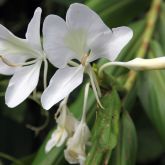White ginger

White ginger flowers
© Queensland Government

White ginger flowers and leaves
© Queensland Government

White ginger plant form
© Queensland Government
Native to southern Asia, white ginger is a herbaceous perennial shrub that is a major problem in a number of countries. White ginger's popularity as a garden plant increases the risk that it may become a pest in Queensland. It forms dense stands that replace native plants.
You must manage the impacts of White ginger on your land.
You must not give away, sell or release White ginger into the environment.
Scientific name
Other names
- Sweet scented garland flower, butterfly ginger, butterfly lily, cinnamon jasmine, garland flower, ginger lily, white butterfly, white butterfly ginger, white ginger lily
Similar species
Description
- Herbaceous perennial shrub 1-3m tall.
- Leaves are 20-40cm long, 4.5-8cm wide.
- Flowers are white and fragrant on spikers 10-20cm long.
- Fruit is a capsule, oblong, smooth, with orange-yellow valves 3-3.5cm long containing many seeds.
- Seeds are pale brown, squarish shape, 3-4mm.
- Roots are thick, pinkish spreading rhizomes.
Habitat
- Prefers humus-rich soils, shaded or semi-shaded areas subject to waterlogging.
Distribution
- Found in Babinda and Millaa Millaa in far north Queensland.
Impacts
Environmental
- Forms dense stands that replace native plants.
How it is spread
- Spread by people dumping unwanted plants.
Prevention
Control
Physical control
- Dig out entire plant, including rhizomes (underground stems).
Herbicide control
- For more information on herbicide control of gingers, visit the Australian Pesticides and Veterinary Medicines Authority website.
Biological control
- No known biological control agents.
Legal requirements
- White ginger is a category 3 restricted invasive plant under the Biosecurity Act 2014.
- You must take all reasonable and practical measures to minimise the biosecurity risks associated with dealing with white ginger under your control. This is called a general biosecurity obligation (GBO).
- It must not be given away, sold, or released into the environment. Penalties may apply.
- At a local level, each local government must have a biosecurity plan that covers invasive plants in its area. This plan may include actions to be taken on White ginger. Some of these actions may be required under local laws. Contact your local government for more information.